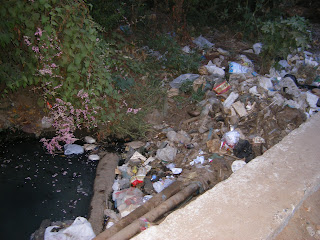With over one billion people in its population that is continuing to grow and a limited amount of land mass and resources, India faces many challenges for the future. Providing adequate amounts of the essentials such as food and water to the people, as well as ensuring sustainability of other important resources is already a challenge and will be even more difficult for the country in the future. While we learned about these issues in class at Furman, I am getting a better and more personal perspective on the issues while living in India.
Ensuring enough energy for the country is one challenge that India currently faces and will be even more of an issue as the population continues to increase. Dr. Lakshmi Narayanan from the Department of Physics at MCC, discussed the energy problems India faces in his lecture on November 9, 2011. He mentioned that not only is energy need increasing because of the growing population, but that the demand for improved living standards is also increasing which will result in greater per capita use. Dr. Narayanan stated that India’s energy use has increased by 16 times in the last 60 years and the installed electric capacity has increased by 84 times. In 2008, India had the fifth highest energy use in the world. As of 2011, the total installed capacity is 182,345 million watts. We have learned that demand often exceeds availability of power while living in India. Power outages occur very frequently, usually multiple times per day. In fact, yesterday we tried to eat at a McDonald’s restaurant but it was closed because the restaurant lost power. This would be unusual in the United States but is just a normal occurrence here in India.
With the demand for energy increasing so much, it is vital that India begin to use more renewable energy sources such as wind and solar energy and to depend less on nonrenewable sources. It is also important that India find ways to conserve energy and some efforts to do this are already in place. We have experienced one such effort first hand. Every day at about 1:00 PM, the power shuts off at MCC. This is part of a daily blackout that occurs in much of the state to conserve energy since demand currently exceeds supply. Luckily, at MCC the power usually comes back on within a few seconds or minutes but in many places it is an hour long power outage.
Clean water is another resource where the demand is greater than the supply, and India must find ways to conserve it. This is particularly important because water is a basic human need for survival and there are already over one billion people that India must be able to provide with safe drinking water. It is unusual to me to think about how India needs more conservation efforts because it seems like people here use so much less water for domestic purposes. For example, in the United States most of us take long showers daily. In India most people take bucket baths and most do not shower daily. The bucket saves a lot of wasted water during showers. However, agriculture and issues with water quality are even bigger thieves of clean drinking water than domestic use. We have observed how much rice is consumed in India and how many rice paddy fields exist. Rice is an extremely water intensive crop so its production may need to be decreased and replaced with a substitute that does not require so much water. In regards to water quality, pollution makes much of the water in India undrinkable. It is unsettling how much trash we have observed on the streets and how there are almost no trashcans. This really becomes a problem when it monsoons because the streets flood and all the trash gets mixed in with the water. When walking in Chennai, we had to cross a flooded street and the water was so gross that we could barely bring ourselves to walk through it. Rainwater harvesting would allow the excess water from monsoon rains to be used later in the year or in drought prone areas. Providing places for trash and enforcing rules for disposing of trash would also improve the quality of the water. Rivers, lakes, and other bodies of water have also become dumping grounds for the wastes of many industries according to Dr. Sukumar of MCC.
Fuel is a third resource that is being threatened by the expanding population. We have observed how congested the streets are with so many cars, buses, motorbikes, and rickshaws. While India has some public transportation such as buses and trains, it needs more infrastructure to encourage use of public and active transport. Also, some of the vehicles being driven are not fuel efficient and more rules should be put in place and enforced so that fuel is conserved. Alternative sources for fuel need to be adopted as well. This is especially important because Dr. Narayanan informed us that India currently imports approximately 80% of its oil from other countries. This will threaten India’s future energy security if the country does not find its own sources of oil, particularly from renewable sources.
Energy, fuel, and water are three of the important resources that are being threatened by India’s large and rapidly increasing population. After being in the country for about a month, we are already able to observe a lot of these issues. While some efforts are in place to conserve resources, more strategies need to be put in place and more renewable alternative resources need to be implemented to ensure sustainability of the resources for the country. Better enforcement of these strategies is also essential.


























